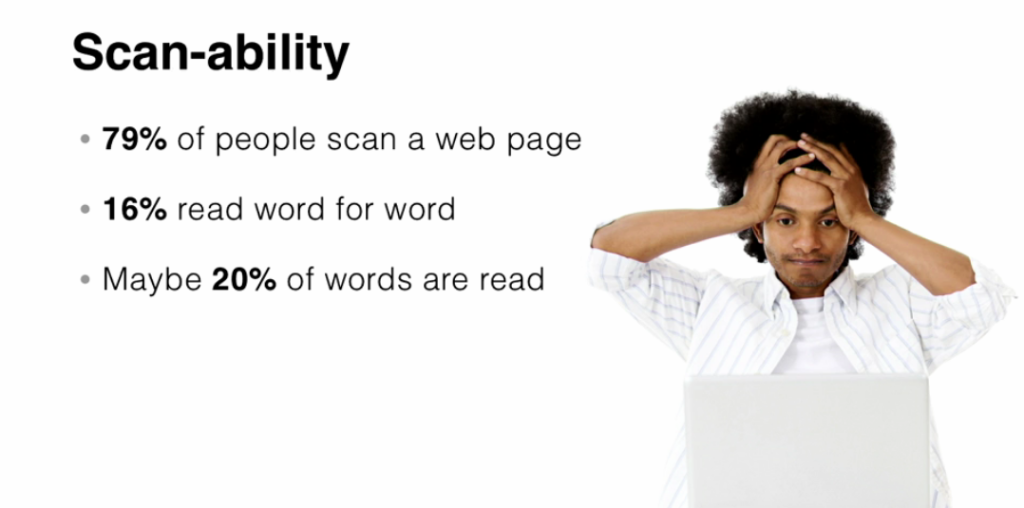In the online world, where the average attention span of a human is now less than a goldfish (8 seconds), you only have that long to catch the reader’s interest. Less really is more. Conciseness is gold.
Writing for the web is different from writing for print.
Rule #1: ssume that people don’t read. They scan.
When curled up on your couch reading your favorite book for pleasure, you may notice that you’re reading it slowly, savoring each word. Compare it to viewing a blog on a mobile device. Time is precious, and information overload on the Internet is a real thing to deal with. You probably won’t scroll further down unless you find a reason not to leave the page. Being hard to read is one of them.
As Ann Handley (marketing expert) puts it,
“Be rabid on readability”.
That’s right. Make it easier on the eyes. Avoid making reading your writing a chore for the reader.
Or, to put it another way, and as Hailey Griffis – host on Buffer App digital marketing podcast – puts it:
“You must earn the reader’s trust by not wasting their time”
How?
Rule #2: Keep paragraphs short
Let’s compare the short paragraph and long paragraph versions below. Which is easier to read?

Most would answer that the first one is much easier and the other one looks too intimidating to read.
This too often makes the difference between your writing being read at all or not, no matter how great a writer you are.
Ann Handley suggests that the best paragraphs contain no more than 3 sentences or 6 lines. There is nothing wrong with a one-sentence paragraph.
See the one above?
Rule #3: Keep sentences short
Think of each sentence as taking a breath.
Just to get a feeling, try reading a long sentence out loud, and compare how different it feels from a short sentence. When it’s too long, reading sentences literally can make you go “out of breath”.
This is true also for the brain when you are reading, silently or otherwise.
Here’s how the brain scans through a sentence:
First, when reading from left to right, the period(.) acts not only as a marker for the next sentence. It signals to the brain that now is the time to evaluate what was just taken in, to form a concrete idea of what was just read. Then it’s ready to move on to the next.
When a sentence is too long, the mind feels somewhat like going out of breath, just not in a literal way. It makes it more of a chore to read.
Ann Handley suggests keeping it no more than 25 words per sentence.
Rule #4: Use punctuation to establish a comfortable pace
To add variety and cadence to your writing, you can further subdivide the sentence using semicolons, commas, dashes, and periods (.) for pacing.
According to Hailey Griffis – marketing expert from Buffer:
- “Short sentences communicate tension.
- Longer or run-on sentences, on the other hand, establish a frantic hurried rhythm”
Rule #5: Let the text breathe
Remember this?

Here’s another reason why shorter paragraphs are better. When the words are too crowded together it’s easy to get lost in the paragraph. Using shorter paragraphs create more pockets of “white space”, which acts as a cushion of sorts, or a sandwich.
White space in your web content is very crucial for readability and “scannability”. It’s easier to follow line-to-line or paragraph-to-paragraph. There are several ways to do this. Here is one.
Rule #6: Add images in between text.
One great way to create white space is to create buffers between sections or paragraphs using images or embedded videos.

A general rule is that its best to embed an image into your blog or webpage no more than every 4 or 5 paragraphs.
There are a number of reasons why you might want to do this, beyond the obvious trope “a picture is worth a thousand words”.

When was the last time you ever saw an ad with only text? The eye is drawn to color and contrast. White space is only one of its many benefits.
This may sound like a no-brainer, but if you’re a marketer, it would be a mistake not to do this.
Rule #7: Use straightforward language
Don’t use embellishments that add no new meaning. Avoid language such as:
- “I think that…”
- “Just so you know…”
- “So, …..”
- “Now that you mention it…”
- “As I mentioned earlier…”
- “I don’t know if you know but….”
Instead, cut straight to the chase, and the punchline of the sentence.
That also means to use adverbs sparingly. Quite too often, adverbs become a crutch for the actual verb, without adding any new meaning.
For example, instead of, “The sky is really blue”, say “The sky is royal”.
Or instead of “It’s really huge”, say “It’s gigantic”
Less roundabout, and more straightforward. Do you agree?
Rule #8: Use simple, not big words, and write as if you are having a conversation.
Remember, this isn’t a resume, a published scientific paper, or a college essay. You’re trying to get noticed. And most important – to be read, of course.
Imagine your blog is addressed to someone close to you. The more conversational the tone, the more personal it sounds. The other person feels as if YOU (instead of an inanimate computer ) are having a friendly chat. The writing has to be “human”-friendly. Or to put it another way, more personable. People tend to prefer it, and so do search engines, simply because people do.
Believe it or not, AI is advanced enough at this stage, search engines now can pick up on more than just typos. They can now discern writing tone, quality, and readability. If you sound robotic or stuffy, you will be demoted by Google and other search engines and show up lower in results, even if it’s otherwise great content.
Bottom line: be conversational in your writing.
For example:
- “led a meeting” instead of “facilitated a meeting”
- “use” instead of “utilize”.
- “many” instead of “a plethora of”
- “science has shown that…” instead of “there exist a substantial number of scientific research findings that suggest…”
And finally,
Rule #9: Break Some Grammar Rules
“I encourage you to safely and fearlessly break those rules and to make those mistakes in writing — but only when doing so lends greater clarity and readability.”
Originally published on:
https://www.linkedin.com/pulse/what-didnt-teach-you-college-writing-web-kevin-kazuhito-naruse/
Sources:
https://www.freelancewriting.com/freelancing/when-words-meet-pictures/



